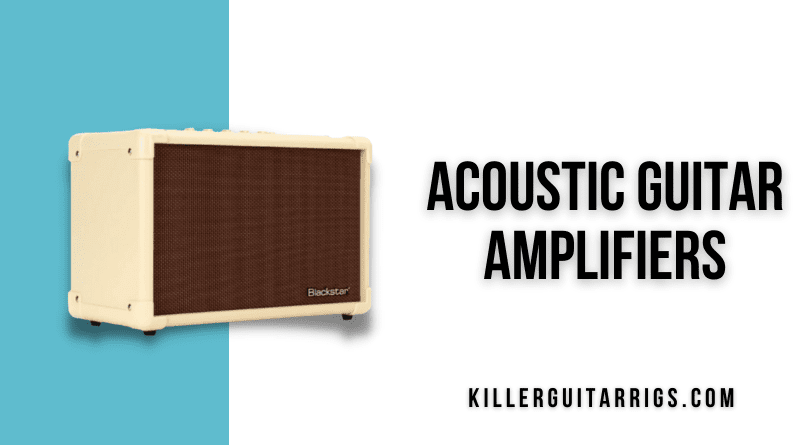If you’re wanting to take your acoustic playing to the next level, you’re going to need to invest in one of the best acoustic guitar amplifiers in order to play for bigger audiences, and we think it’s really hard to beat the Fender Acoustasonic 40. This amp is a fantastic all rounder, and delivers a great blend of practicality and performance. With 40 watts of power it’s loud enough for everything from outdoor busking to small/medium gigs, and even when cranked it maintains superb sound quality. If you’re a singer songwriter, you’ll love that it features XLR mic inputs as well as instrument line in, and with its 3 band EQ, you’ll have full control over sound shaping. It looks great, sounds fantastic, and because of all this, we think the Fender Acoustasonic 40 is a worthy winner of our best acoustic guitar amplifiers Top Pick Award.
Now, if you’re in the market for something a bit more powerful, with more advanced features, then the Boss Acoustic Singer Live LT 60. Featuring a robust 60 watt output, this amp offers plenty of power for gigging, and thanks to its independent dual channels, you’ll be able to EQ both your mic and guitar separately for optimum tone. It’s one of the most flattering acoustic amps on the market, and can bring even the dullest piezo pickups to life. Beyond the basic features, it boasts the ability to send a DI signal straight out to front of house for bigger gigs, and even USB out, allowing you to use this amp as an interface for recording. Despite all the power and features, it’s still highly portable, too. The high end feature set on the Boss Acoustic Singer Live LT 60 made it the obvious choice for our best acoustic amplifiers Editor’s Choice award.
For budget conscious players we’re going back to Fender and their fantastic Fender Acoustasonic 15. This amp may have entry level pricing, but it still offers tones and performance that far exceed its price point. It features a 6” full range speaker, which delivers a really broad frequency spectrum for a smaller amp, and even comes with an XLR jack for dynamic mic input – perfect for taking those first steps into gigging, or even for more experienced players looking for something super lightweight. It features 15 watts of power, and serves up a surprising amount of volume considering both its small speaker size and relatively low output. It works well for jamming, busking, and even small gigs. For the price, there’s no beating the Fender Acoustasonic 15, and that’s why it’s our best acoustic guitar amplifiers Best Budget pick!
Read more about our review process.
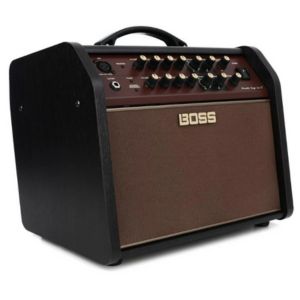
Boss Acoustic Singer Live
Features: Multiple on board FX, Anti feedback knob, PA functionality
Benefits: Accurate guitar/vocal representation, High clean headroom, Extremely portable
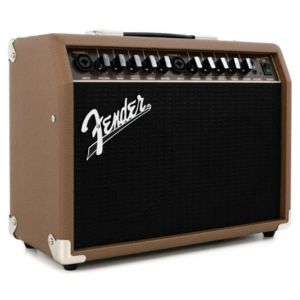
Fender Acoustasonic 40
Features: 3 Band EQ, 40 watts of power, Digital reverb
Benefits: Full tones, Easy sound shaping, Gig ready
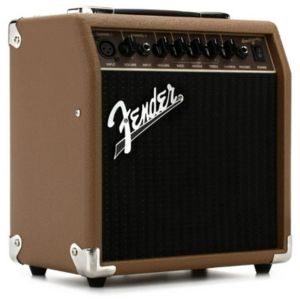
Fender Acoustasonic 15
Features: 6" Full range speaker, XLR Mic input, Chorus effect
Benefits: Basic PA functionality, superb for practice, Accurate tonal representation
Contents
Individual Reviews
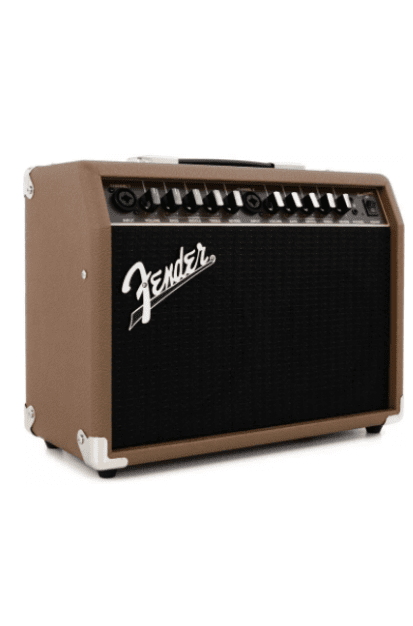
Fender Acoustasonic 40
A tremendous all round workhorse of an amplifier.
When you absolutely need pristine clean tones, the first and last word in amplification has to be Fender, and this amp delivers every time. It offers enough power for gigging, two speakers for stereo effects, and a second input that's perfect for a microphone.
Fender has a storied history in amplifier manufacturing, but their reputation has arisen mainly from their electric-guitar tube amps, so we were very excited to see how the 40-watt, solid-state Acoustasonic 40 performed (full review here). This amp certainly looks the part. It’s finished in attractive brown Tolex, as is popular with many acoustic amps, and the fit and finish were solid, as expected from a Fender.
The clean tones were simply fantastic. The two 6.5” speakers reproduced all of the natural punch of the Sitka spruce from our Martin D10, but it never felt overpowering. We were able to dial in the EQ to accurately portray the sparkly highs we get from this guitar when unplugged. With very little tweaking, it was also able to reflect the warmth that this guitar boasts with gentle strumming.
The Acoustasonic 40 does feature a second input, so we were able to check the vocal response, and we were more than happy with the results. The second channel gets its own EQ adjustment, so we were able to dial in for both guitar and vocals simultaneously.
As for built-in FX, this amp was limited to a simple reverb controlled by a rotary dial, but in all honesty, it didn’t need anything more. The reverb added some nice depth, and at no point did it feel artificial. If you want to play with a backing track, there’s an aux-in that will allow you to do so, and should you need to, you can also hook this amp up to your PA system to use as a monitor.
Verdict: We found that the Fender Acoustasonic 40 gave us a great blend of functionality, power, and price. This is a practical amplifier that will suit the needs of almost any acoustic guitar player. The power and overall volume suit everything from bedroom practice to small indoor gigs. For the solo artist, the ease of connecting media players for backing tracks makes it an attractive prospect.
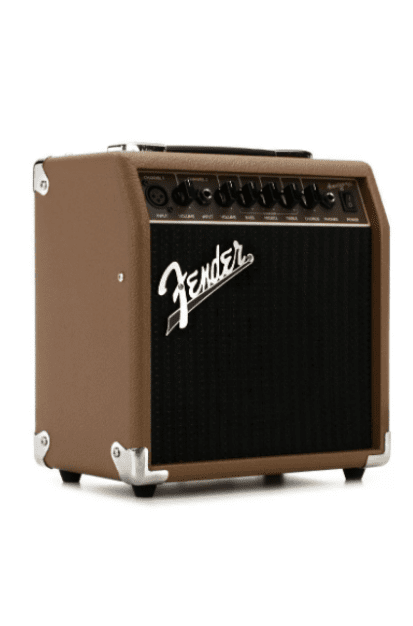
Fender Acoustasonic 15
A true practice amp at a price to fit all budgets.
This is a feature packed amp with great tones that manages to get surprisingly loud for 15 watts. It's affordable, looks great, and offers the legendary Fender reliability that has kept them at the top of the amp game for decades.
The Acoustasonic 15 might be the perfect practice amp for the acoustic player (full review here). It offers almost all of the features of the larger Acoustasonic 40 but comes in at under half the price. As with the 40, the Acoustasonic 15 is finished in an attractive vintage Tolex, and the build quality was equally good.
The tones were very neutral. In fact, they were almost indistinguishable from the unplugged guitar across the board. While it’s rare to play 15-watt practice amps at full volume, we made sure to check that the single 6” whizzer cone speaker didn’t begin to distort with heavy strumming and high volume. We can gladly report that even when cranked, the little 15-watt Acoustasonic keeps its composure. Similarly, with fingerpicking, we found that it maintained clear note separation and brought out the highs in the most natural way.
Incredibly for a sub-$150, 15-watt practice amp, it featured a second channel specifically for microphone use. The mic channel didn’t have individually adjustable EQ, but simply having the facility to plug in a mic was appreciated at this price point.
Built-in EQ controls included bass, middle, and treble, as well as individual volume controls for each channel. There was a great built-in chorus effect controlled by a rotary dial. It added some presence but didn’t sound unnatural.
Verdict: We thought very highly of the Fender Acoustasonic 15. This is a great practice amp, and in a pinch, we’re sure you could probably even use it for small coffee-house-type gigs. It’s highly portable, well-made, and offers sound quality and features far exceeding its price point.
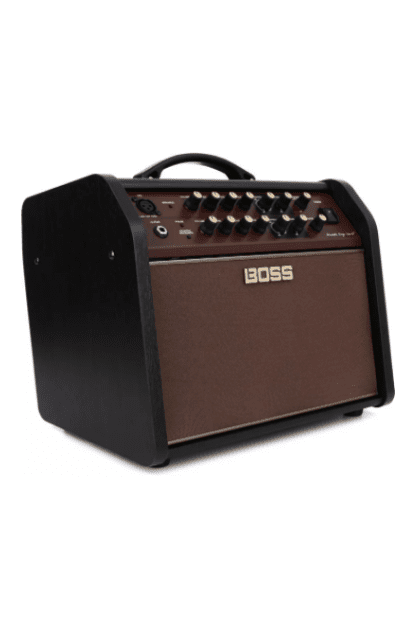
Boss Acoustic Singer Live LT60
The looks and performance of a boutique amp with legendary Boss reliability.
If you're looking for a range of incredible tones, with exceptional clarity, huge volume, and instantaneous response, look no further than this Boss amp. It provides separate guitar and mic inputs for the singer/songwriter, and each channel gets its own dedicated EQ for fine tuning vocals and instrument channels.
The Boss Katana series has made a big impression on the KGR team recently for their amazing tones, superior build quality, and incredible feature sets (check out our review of the 50w here). It turns out Boss makes a great acoustic amp, too. The Acoustic Singer LT60 is a 60-watt, all-in-one PA/acoustic guitar amplifier designed for the working musician (full review here).
Tonally, this was easily the clearest, cleanest amp we looked at. It gave us about as true a representation of our acoustic guitar as we think is possible, or at least as is detectable by the human ear. Much of the accuracy comes from the fact that this is a bi-amped setup. This means the woofer and the tweeter in the speaker setup get their own individual power amp. Without getting too technical, we can absolutely say that this tech works. Whether we were fingerpicking, strumming hard, or playing gentle arpeggiated passages, we felt that the natural character of the guitar was always properly represented.
As you’d expect, there are individual input channels for a mic and for a guitar, and both feature independent EQ and FX. The vocal channel was responsive and dynamic, both with and without a guitar playing simultaneously.
There was full-scope EQ on board, including bass, middle, and treble adjustment. The vocal channel offered delay, echo, and reverb, all of which worked very well to add some color to our vocals without disrupting the guitar’s organic tones. The guitar channel offered delay, chorus, and reverb, which again didn’t distract from the natural sound.
Verdict: Ever since it was revealed at NAMM in 2020, the Boss Acoustic Singer Live LT 60 has been the benchmark for the singer/songwriter acoustic guitar amp and PA combo. It’s highly portable yet powerful enough for mid-size indoor gigs and potentially even outdoor performances. The sound quality is perfect for studio use, and it could well be the ultimate acoustic guitar amp.
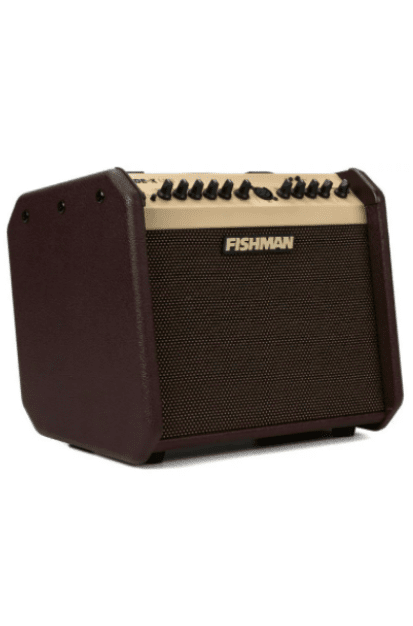
Fishman Loudbox Mini BT60
Big power and Bluetooth connectivity in a tiny package.
This high tech take on the acoustic amp employs bluetooth technology to make it simple to add and play along with backing tracks - perfect for the solo artist. It's beautifully made, and offers enough power to take on decent size gigs. A solid choice for the working musician.
Fishman is a big name in acoustic guitar electronics. Their Loudbox amp series has been a huge success amongst acoustic players, and the Mini BT 60 is a big part of their popularity. First of all, we absolutely loved the design of this amp, which was retro without being kitsch. The build quality was excellent and included plush, leather-effect Tolex, a matte-gold panel, and gold-accented grille cloth.
The tone test went very well for the Fishman. It offered a very balanced, neutral sound profile through its single 6.5” woofer and 1” tweeter, with no excess coloration and no particular bias towards any end of the EQ range. We were satisfied with the accuracy of the tones and with the responses to fingerpicking, as well as heavy and gentle chord-strumming.
The Loudbox Mini BT 60 does feature two channels, 1 for guitar and one for XLR input mics. There is a master volume control, and both inputs have individual EQ controls as well as individual gain. The vocal response was good but a little flatter than we found on the similarly-priced Boss ASL.
There are some built-in FX, including chorus and reverb on the guitar input, and just reverb on the vocal channel. Overall, the FX were good, but we did find that the chorus sounded a little unnatural.
One of the most impressive features was the Bluetooth connectivity. The pairing was fast and simple, and we were easily able to play backing tracks through the amp to jam along with – a great feature for solo performers.
Verdict: The Fishman Loudbox Mini BT 60 is a great amp if you demand excellent portability and the convenience of Bluetooth connectivity. Sadly, it fell just a little short when it came to the built-in FX and vocal response. If you plan to play clean most of the time and you won’t be singing, this should definitely remain in play.
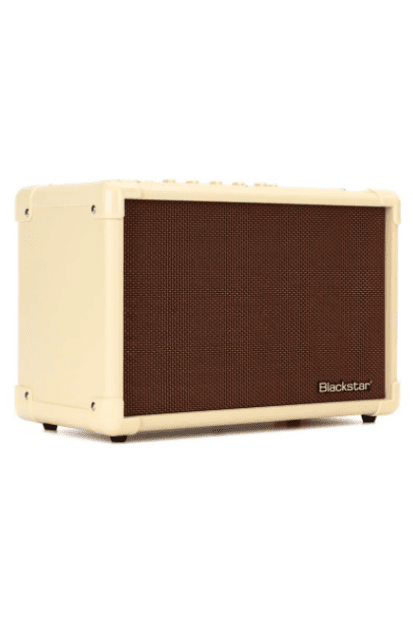
Blackstar Acoustic: Core 30
A decidedly modern take on the acoustic guitar amp.
With this amp you're getting great tones, stunning good looks, and some fantastic technology in a relatively afforadble package. It has enough power to handle small gigs, but not so much that it isn't manageable at studio or even bedroom volumes. It features individual instrument and vocal channels and a host of EQ and FX controls for fine tuning texture and tone.
Blackstar have been pioneers in small-amp technology in recent years, having revolutionized the micro amp from a novelty into a genuine practice tool. The Blackstar Acoustic: Core 30 continues this trend, bringing acoustic players an amp that is as suitable for bedroom practice as it is in the studio or at small gigs.
We were once again happy with the tone test. We didn’t encounter any particular bias in the sound from the dual 5” speakers, and we found that the note separation and clarity while fingerpicking was amongst the best of any of the amps on trial. In soft strumming, we did lose a little of the responsiveness, and with the volume cranked and heavy strumming, we did encounter some rattles.
As with all of the other amps on test, the 30-watt Acoustic: Core 30 featured an instrument-in and a mic-in channel. Both had their own EQ, although the guitar channel featured low and high controls but no mids. The vocal channel did feature a full range of EQ controls (low, mid, and high). The vocal response was generally good, and we loved the vocal-clarity-enhancer button, which really tidied up the responsiveness with minimal effort.
The guitar line-in also featured an enhance button, but unfortunately, it felt a little gimmicky. With enhance on, we lost a lot of the natural tone of the guitar, and everything felt very artificial. The guitar channel did feature chorus and reverb FX, both of which worked very well, complementing the tones rather than drowning them. The vocal channel also featured reverb, which added some nice depth.
Although we didn’t try it, this amp can accommodate a footswitch, which is a great feature if you’re planning to use it for live performances. The USB-out was another pleasant surprise, as it allowed for direct USB-out recording via a computer.
Verdict: The Blackstar Acoustic: Core 30 is a technologically advanced acoustic guitar amp with some great features that make it as good a fit for the studio as it is for the stage. It was full of nice touches that we didn’t see elsewhere, that in many ways, made up for the minor flaws. We really loved the kickstand in particular, which allowed for this amp to be used as a properly positioned monitor.
How to Choose The Right Amp For You
If you’re new to amplifying acoustic guitars, you’re probably wondering whether there’s a difference between acoustic and electric guitar amps and whether it’s even worth bothering with a specialist amp. Keep on reading to learn more about why playing an acoustic guitar through the correct amp type can make a huge difference to your playing experience
Are Solid State or Tube Amps Better for Acoustic Guitar?
While this piece isn’t aiming to settle the age-old tube amps vs solid-state amps for electric guitar argument, we are going to explain why one is particularly better than the other when it comes to acoustic guitar amplification.
As the aim of an acoustic guitar amplifier is to create a clean, neutral sound, the best choice in this case is a solid state.
Tube amps are widely considered to be the gold standard in electric-guitar amplification, but this is mainly because of their ability to break up naturally in an ear-pleasing way without the need for distortion pedals or overdrive FX. Tube amps provide an organic warmth in a way that solid-state amps can’t, but as we know, this isn’t the optimum tone for an acoustic guitar.
A solid-state amp should not generate breakup or distortion with the volume increase in the same way as a tube amp. Acoustic-guitar amps in particular, should maintain a clean tone at any volume.
What Are the Different Types of Amps for Acoustic Guitars?
As with electric guitars, there are acoustic guitar amps to serve different purposes, depending on what you need from them. Keep reading to learn a little more about each type.
Practice and Travel
The great thing about an acoustic guitar is that you don’t require amplification to practice and hear yourself, but there are a few circumstances where it might be beneficial to have access to an acoustic guitar amp, even at home.
First, by playing through an amp, you may well be able to play it through to headphones if your amp has an aux out. This is handy for practicing nuanced techniques, especially if you’re practicing in a noisy or crowded area.
If your amp has an aux in or even Bluetooth, you can load up a backing track to practice along with. Additionally, if you want to practice with a looper pedal (like Ed Sheeran), you’ll need an amplifier.
If you’re planning to use your amp for travel or busking, consider a battery-powered amp with either rechargeable batteries or one that can take disposable batteries. This will be especially helpful if you’re playing somewhere without access to the main power.
Amps for the Studio
If you’re planning to invest in an amp for a studio or even for a home studio, you’ll need to go with a model that keeps the recording process as straightforward as you can.
Especially in home studios, recording directly from a mic’d-up guitar isn’t always ideal. If the room acoustics aren’t what you’re looking for in a particular take, adding echo, reverb, or chorus through an amp can add the depth you’re looking for without excessively coloring the natural tones.
Amps for Gigs and Live Performances
Depending on the venue size, you’ll likely need something a bit more powerful than what you’d use for bedroom practice if you’ll be playing any kind of live performance. For small indoor venues, you’ll find that amps as small as 40-50 watts are more than sufficient. But as the venues get larger, or if they are in outdoor settings, you’ll need more power to meet the volume needs.
What to Look For
Once you’ve established how you’ll be using your amp (practice, studio, or performing), you can start thinking about the features you’ll need in your new acoustic guitar amplifier.
Power
Amplifier power is measured in watts, and the lower the figure, the less powerful the amp is. Portable microamps are available with as little as 3 watts of power, whereas amps for acoustic guitarists playing loud venues can draw as much as 400 watts.
Speakers
Combo amps house both the amplifier and the speaker within a single cabinet. The size of the speakers varies depending on the power of the amp but normally ranges between 6-12”. In some cases, the cabinet houses multiple speakers. The larger the speakers, the more air the amp can move, which results in greater volume. The same can be said for multiple speakers. A 2×12” will be able to produce greater volume than a 1×12” before breaking up.
Onboard Effects
While acoustic guitar amplifiers aren’t designed to alter the organic tones of the guitar, they do often have ambient effects built in. These are designed to replicate some of the more ear-pleasing room effects that aren’t always easy to replicate, such as reverb, chamber echo, etc.
Inputs
If you’ll be plugging a microphone into your amp at the same time as your guitar, or if 2 or more guitars will be playing simultaneously, you’ll need to ensure that the amp has multiple inputs.
Portability
If you’ll use the same amp for practice and performance, be aware of the size and weight. For those needing to easily move between places on public transport or smaller modes of private transport, a 300-watt Mesa/Boogie Rosette might not be the best call! If you can budget for both, then this becomes less of a concern.
Final Thoughts
Acoustic guitars fully deserve to be heard by your audience just as the luthier who made them intended. By plugging into electric guitar amplifiers, you aren’t doing your guitar’s tones any favors!
All of the amps featured in this guide are worthy of your attention, but if you’re in need of a reminder of our favorites…
Our Top Pick, the Fender Acoustasonic 40, is a superb choice for players looking for something they can gig, record, or practice with. Budget-conscious players should look to the Fender Acoustasonic 15 for a feature-packed and highly portable practice amp. Finally, our readers who are interested in a top-quality, powerful acoustic guitar amp and micro PA should look no further than the Boss Acoustic Singer Live LT 60.

